
How Twitter’s Open Direct Messaging Will Affect Customer Relationships
Twitter is removing a little bit of the awkwardness of social media conversations with a new setting: allowing anyone to direct message (DM) anyone else, regardless of who follows who.
In the past, Twitter restricted direct messages to just the accounts that follow you. Now Twitter users can enable a setting to receive direct messages from anyone.
Why allow DMs from anyone? It’s an additional way for your clients and prospects to contact you online, and it may be a bit quicker and easier for them than going to your website and filling out a contact form, says social media strategy consultant and author Neal Schaffer.
“If I had a quick question for a company, because I’m an active Twitter user, my first choice would be to go to Twitter. If I could do that in a direct message rather than an at (@) mention, knowing that it’s going to get into their inbox, I might be willing to do that more often,” Schaffer explains.
Allowing DMs from non-followers is clearly a great option if you use Twitter for customer service. You may, however, be using Twitter primarily for lead generation and/or brand awareness for your business. “Enabling the DM will only allow you to potentially receive information that was not meant for other eyes,” Schaffer explains. “I think it’s a good option to have.”
However, he does offer a warning: “On the flip side, we don’t know how much spam that’s going to attract.” To date, Twitter has prevented a lot of automated tools from sending indiscriminate spam, but that’s no guarantee it will stay that way.
Schaffer thinks it’s worth testing, though. “I believe people should turn it on, and if they see spam coming, they should turn it off.” He points out that those who indiscriminately follow users they don’t know very well can get inundated with spam as well.
How does this affect your business?
Schaffer points out that some Twitter accounts already had the ability to send or receive DMs to and from non-followers.
“If you’re a verified account, like most big brands, you already have the ability to accept DMs from people you don’t follow,” says Schaffer. “I believe Twitter enabled them to do that because if there was a customer service complaint or a customer service issue, they could quickly take that conversation offline through the DM without having to follow that person back. So I think the initial push for that functionality was from a customer service perspective.”
From a public relations standpoint, dealing with complaints offline is preferable to communicating via a Twitter feed for all to see. Allowing all users the option of sending you a DM puts you one step closer to clients and customers.
Similar options on other social media platforms
Facebook allows individuals to send private messages to business and personal accounts, even if you aren’t “friends.” The downside is sometimes those messages land in the “other” folder, which acts more like a traditional spam folder and which some users may not check often.
LinkedIn allows members who are “connected” to exchange InMail messages. But to be able to send messages to those outside their immediate network, users are required to sign up for a premium plan, which starts at $19.95 a month.
How to turn it on

To set your Twitter account to receive DMs from anyone, go to the accounts settings page and scroll down until you see “Messages.” Click on the box to check “Receive direct messages from any follower.”
You’ll see the following explanation:
“Generally, you must follow someone before they have the ability to direct message you. If you check this option, any Twitter user that follows you will be able to send you a DM, regardless of whether you decide to follow them back.”
If you follow the instructions and you don’t see the option to turn this feature on, check back at a later date; Twitter is rolling the new feature out in phases.
Will this change who you follow?
The new DM feature could have potentially big implications if you’ve been following large numbers of your own followers in order to allow them to contact you privately. This should allow businesses to be more selective about who they follow and why.
Schaffer recommends following target customers. “By following someone, you are sending a social signal. It means that you think they are important,” he explains, and that you’re interested in the content of their tweets.
The social media strategy consultant advises to only follow back users who work in the industry you or your company are targeting. This advice goes for people who may not have been on your radar, but could have potential business importance. “There’s no reason to follow them back if they tweet things that are irrelevant to your company,” he explains.
Do you plan on receiving DMs from anyone? Why or why not?
This post contributed by guest author, Yael Grauer. Grauer is a Minneapolis-based freelance writer and editor. Find her online at Yaelwrites.com.
© 2013 – 2018, Contributing Author. All rights reserved.




This is still being rolled out Craig. It hasn’t been updated in everyone’s account yet. Give it a little more time.
I’ve looked on the Account Settings page (and elsewhere), and I don’t have that option.
It is a good idea for a company indeed. I’m leaning towards enabling this feature for our company Twitter account. Thanks for sharing!